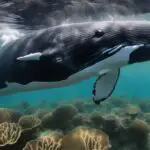Blue whales are the biggest animals on Earth, reaching lengths of up to 110 feet and weighing as much as 330,000 pounds. But, you might ask, are blue whales endangered? They are listed as endangered on the IUCN Red List, showing they are at risk.
The decline in their numbers comes from commercial whaling in the past and ongoing threats. Today, there are only about 10,000 to 25,000 blue whales left in the wild. This highlights the need for conservation efforts to protect these incredible creatures.
Status of Blue Whales: Endangered or Recovering?
It’s vital to know how many blue whales are left to understand their recovery chances. Despite big efforts to save them, they are still endangered. The Antarctic blue whale, a type, is even more at risk. Humans have caused a huge drop in their numbers, with over 90% gone.
Current Classification and Numbers
Now, blue whales are under strict rules to protect their homes and help them come back. They are in a tough spot, showing the need for more conservation work. Some groups are slowly getting back on their feet, growing by about 7% each year.
Population Recovery Efforts
Work to help blue whales is showing good signs. Important steps include:
- Establishment of Marine Protected Areas: Protecting key places helps with breeding and eating.
- Reduction of Ship Speeds: Slower ships help avoid hitting whales.
- Removal of Ghost Gear: Taking out old fishing gear stops whales from getting tangled.
These actions help with saving blue whales and tackle the main threats from humans. They show how important it is to work together for the ocean’s health.
| Conservation Efforts | Status | Impact |
|---|---|---|
| Marine Protected Areas | Active | Increased safe breeding zones |
| Ship Speed Regulations | Implemented | Fewer vessel strikes |
| Ghost Gear Removal | Ongoing | Lower entanglement incidents |
Are Blue Whales Endangered?
Blue whales face a tough situation due to human actions. Their story shows how hunting by humans put them in danger. This hunting, mainly for their oil, greatly affected their numbers.
Historical Context of Blue Whale Endangerment
From the 1800s to the mid-1900s, blue whales were hunted a lot. Over 350,000 were killed for their blubber, which was used for oil during the Industrial Revolution. This hunting greatly reduced their numbers, causing a big worry about their future.
By 1970, laws were made to protect blue whales. Now, efforts are focused on fixing the damage from whaling.
Impact of Commercial Whaling
Commercial whaling had a huge effect. It led to a big drop in blue whale numbers and harmed the ocean’s balance. Losing such a big predator changed the ocean’s health.
Today, as blue whales recover, we remember the harm done by whaling. This reminds us of the need for conservation and protecting these sea giants.
Threats to Blue Whales
Blue whales, the biggest animals on Earth, face many challenges. Human activities threaten their survival in our oceans. These threats include entanglement, collisions with vessels, and noise pollution.
Entanglement in Fishing Gear
Entanglement is a big threat to blue whales. About 60% of them in some areas get caught in fishing gear. This traps them and makes it hard for them to feed and move, making them stressed and vulnerable.
Vessel Strikes and Shipping Traffic
Vessel strikes are another big risk. These can be deadly, especially in busy shipping lanes near the coast. With more ships on the water, this danger is getting worse. We need better ways to manage ship traffic.
Noise Pollution
Noise from human activities disturbs whale communication. Important sounds for finding their way and talking to each other get drowned out by human noise. This can confuse them and mess with their travel plans, adding to the harm they face.
Climate Change and Environmental Impact
Climate change is changing the ocean, affecting blue whale homes. Warmer seas change where krill live, which is what blue whales eat. With less krill, it’s harder for blue whales to survive, making their situation even tougher.
| Threat | Description | Impact on Blue Whales |
|---|---|---|
| Entanglement | Getting caught in fishing gear | Restricts feeding and migration |
| Vessel Strikes | Collisions with ships | Can be fatal, especially in traffic-heavy areas |
| Noise Pollution | Disruption from industrial sounds | Affects communication and navigation |
| Climate Change | Changes in ocean temperature and food supply | Complicates survival due to krill scarcity |
Blue Whale Conservation Efforts
Protecting blue whales needs strong international rules and help from nonprofits. Knowing about these efforts helps us all support these huge animals.
International Protection Regulations
Global laws are key to saving blue whales. The International Whaling Commission (IWC) banned commercial whaling. Countries also have their own laws to help protect these whales and their homes.
Nonprofit Organizations and Initiatives
Many nonprofits lead the way in saving blue whales. They do things like:
- Cleaning the ocean to remove trash and fishing gear.
- Working with shipping companies for safer paths.
- Teaching people about why we need to save blue whales.
Together, these groups are finding better ways to protect blue whales and keep our oceans healthy.

| Organization | Focus Areas | Key Achievements |
|---|---|---|
| Ocean Conservancy | Marine debris removal, habitat protection | Thousands of tons of plastic removed from oceans |
| Whale and Dolphin Conservation | Public awareness, policy advocacy | Successful campaigns leading to increased regulations |
| National Oceanic and Atmospheric Administration (NOAA) | Research, policy enforcement | Monitoring of whale populations and protection measures |
These efforts show how important it is for everyone to help protect blue whales. By understanding how rules and groups work together, we can all do our part to save these amazing creatures.
The Ecological Importance of Blue Whales
Blue whales are key to marine ecosystems. They are the biggest animals on Earth and help keep the food web balanced. They do this by controlling krill populations.
These huge creatures also help with the nutrient cycle in oceans. Their eating habits and waste help fertilize phytoplankton. This is crucial for capturing carbon and keeping the ocean healthy. Blue whales show that a marine ecosystem is thriving.
Without blue whales, the ocean would suffer greatly. Losing them would cause big problems for other sea life. This shows how important they are for keeping nature diverse.
Here are some key aspects of the ecological importance of blue whales:
- Regulation of Krill Populations: They keep krill numbers in check, which is important for many marine animals.
- Nutrient Cycling: Their waste helps fertilize the sea, supporting marine life and phytoplankton.
- Indicators of Ocean Health: The health of blue whales tells us about the state of the ocean.
This shows how important blue whales are not just for themselves but for the ocean. Saving this endangered species is crucial for the ocean’s health and balance.
How You Can Help Blue Whales
Supporting conservation efforts is key to helping blue whales survive. You can help by backing organizations focused on marine conservation. These groups work on research, advocacy, and education to fight threats to these huge animals.
Using less plastic is also crucial. By cutting down on single-use plastics and choosing reusable items, you reduce ocean pollution. Joining beach cleanups keeps the coastlines clean and teaches us about the need for healthy oceans. Also, speaking out against commercial whaling and choosing sustainable seafood helps protect blue whales and their homes.
Talking about the dangers blue whales face and their importance in the ocean can inspire action. Being part of social talks or educational events spreads the word. Following boating rules and navigating safely also lowers the chance of hitting whales. Every action you take helps protect blue whales and ensures they thrive for the future.
FAQ
Are blue whales endangered?
Yes, blue whales are endangered. They are listed as such on the IUCN Red List. Their numbers have greatly decreased due to past whaling and current threats.
How many blue whales are left in the wild?
There are only about 10,000 to 25,000 blue whales left. This number is a cause for concern about their future and the need for conservation.
What are the main threats to blue whales?
Blue whales face threats like getting caught in fishing gear, being hit by ships, noise pollution, and climate change. These threats affect their feeding, migration, and communication.
What efforts are being made for blue whale conservation?
Conservation efforts include laws against commercial whaling, creating marine protected areas, and work by nonprofits to clean oceans and improve shipping safety.
Why is it important to protect blue whales?
Blue whales are vital to marine ecosystems. They help control krill populations and support nutrient cycles. Losing them could disrupt the balance of the ocean and harm many other marine species.
How can I help with blue whale conservation?
You can help by giving to marine protection groups, using less plastic, joining cleanups, speaking out against commercial whaling, and spreading the word about their situation.
What is the historical context behind blue whale endangerment?
From the 1800s to the mid-1900s, blue whales were hunted for their blubber. This led to nearly wiping them out. Over 350,000 were killed, greatly reducing their numbers.
Are there specific subspecies of blue whales at greater risk?
Yes, some subspecies, like the Antarctic blue whale, are critically endangered. This shows the need for conservation efforts tailored to their unique challenges.







